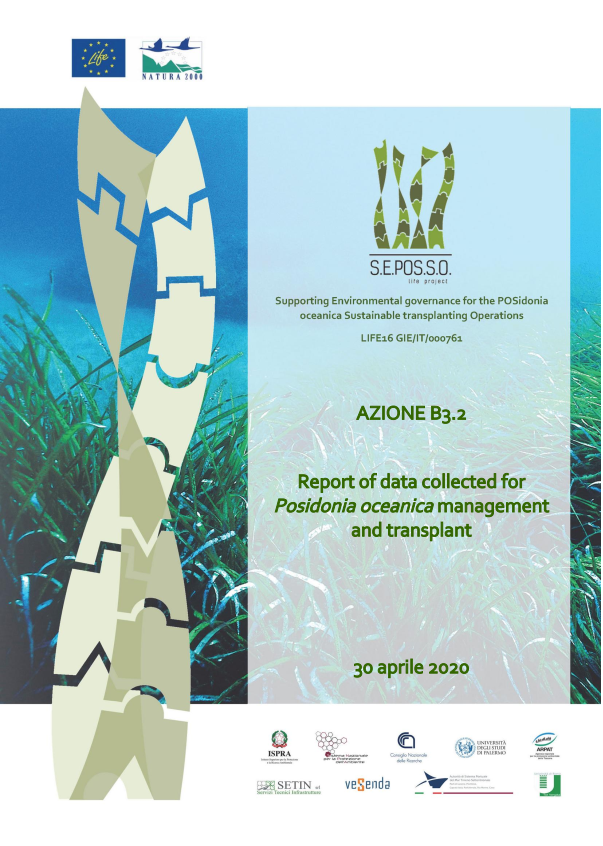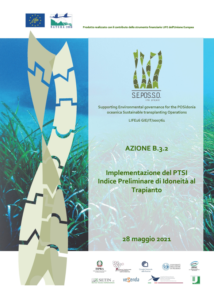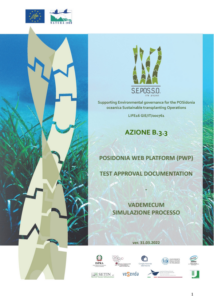Action B.3.2: Implemention of Preliminary Transplant Suitability Index (PTSI)
As part of this action, new and further data were collected and evaluated for the implementation of indices aimed at the preliminary selection of suitable sites for transplanting P. oceanica.
The correct management of a transplant operation requires specific technical and scientific skills, as well as the application of a specific procedural process, which allows the correct management of all the phases of the intervention. In this regard, numerous studies have found that careful selection of the recipient habitat is of great importance for the success of a transplant. In fact, the choice of the receiving prairie where to carry out a transplant operation should always be supported by a good knowledge of the local environmental and geographical aspects. In particular, these are important in order to enhance the state of knowledge of the ecosystem features at the local scale (survey site).
Recently, qualitative and quantitative models have been developed for the identification of potential areas for seagrass transplantation. Recently the P.T.S.I. (Preliminary Transplant Suitability Index), originally developed for Zostera marina, was applied to select areas suitable for transplanting Posidonia oceanica in the Gulf of Palermo (Pirrotta et al., 2015).
Report of data collected for Posidonia oceanica management and transplant
The document reports the recognition of environmental data deemed useful for the management of the Posidonia oceanica meadows habitat and for the planning of transplantation activities of P. oceanica. The environmental data collected, deriving both from research and routine monitoring analyses, were selected from the data made available by the Public Administrations, both at national and local level, or at European level, through data infrastructures and services.
In addition to public environmental data, a survey was carried out of all available environmental information among those collected by a variety of subjects, public and private for the Environmental Impact Assessment (EIA) procedures or for other projects (e.g. projects research oriented to environmental restoration). In the report, the search was restricted to the data relating to the Regions affected by the 4 case studies: Tuscany (Piombino case study), Lazio (Civitavecchia / S. Marinella case study), Campania (Ischia case study) and Sicily (Augusta / Priolo case study).
The recognition of environmental data, together with the results obtained from Action B2 (Monitoring the performance of existing Posidonia oceanica transplants) will substantiate the information basis for the implementation of the PTSI index. An application of the index will be carried out in the four case studies mentioned.
Furthermore, an analysis of the critical issues relating to the selected data (availability, accessibility and usability) was carried out, to obtain useful information for structuring the information in the Posidonia Transplanting Web Platform (PTWP) and for the implementation of the metadata structure in compliance with Directive 2/2007/EU “INSPIRE”.

DELIVERABLE Action B.3.2 – Report of data collected for Posidonia oceanica management and transplant – 30.04.2020
B.3.2_ANNEX_1 – Catalogue of environmental data from public sources
B.3.2_ANNEX_2 – Catalogue of environmental data from the 4 case studies
Implementation of Preliminary Transplant Suitability Index (PTSI)
The document was produced with the intention of providing a contribution to the implementation of the Preliminary Transplant Suitability Index (PTSI) sensu Pirrotta et al. (2015), within the action B.3 (Electronic systems to support transplanting governance) of the LIFE
S.E.POS.S.O, as a tool to support the identification of potential suitable sites for pilot transplantation of Posidonia oceanica.
Among the possible factors that can directly influence the success of transplants, the suitability of sites to receive them is considered among the most relevant. Particular attention has recently been paid to the way in which sites are selected, by means of multi-criteria models capable of simulated consideration of the various characteristics that together confer suitability to a site.
The first part of the paper was devoted to a description of the state of the art related to the PTSI index placed in a more general modelling context. In the second part, information found in the literature or resulting from the LIFE S.E.POS.S.O. project activities themselves was examined. In addition, the aspects concerning the collection, processing and elaboration of data available in the main study sites (Piombino, Ischia, Augusta-Priolo, Santa Marinella) of action B.2 (Monitoring performance of existing Posidonia oceanica transplanting), where transplanting already exists with different outcomes, were dealt with.
Finally, in the last part, the PTSI was calculated, providing an example of the results obtained in the four study areas considered within the LIFE S.E.POS.S.O project (Piombino, Ischia, Augusta-Priolo, Santa Marinella); the distribution maps of each parameter for the calculation of the PTSI, as well as the distribution map of the PTSI values, are reported in Annex 1.
ANNEX_1 – Score maps obtained by selected parameters and PTSI calculation
Technical manual for PTSI plugin
This document constitutes the technical manual of the QGIS plugin that permits the calculation of the Preliminary Transplant Suitability Index (PTSI), resulting from the work carried out under Action B.3, which concerned its implementation as an electronic tool to support the preliminary selection of sites intended to receive transplantation interventions with Posidonia oceanica. Only after verifying the outcome of pilot transplants, can the suitability of a site be defined to accommodate a transplantation operation with P. oceanica. PTSI, was developed in Python code as a plug-in for QGIS (for QGIS versions ≥ 3.16.0) as part of the project. The various individual parameter maps, along with the final map on the distribution of PTSI values at the Site are calculated. Since the suitability of the recipient site increases as the PTSI increases, when selecting areas to receive a pilot test it is recommended to choose those with higher scores within which to replicate pilot transplantation tests in multiple areas.
 |
Plugin PTSI for QGIS – Download |


